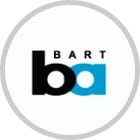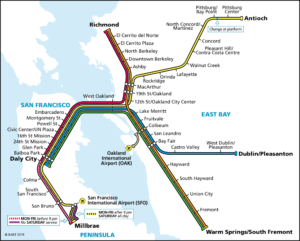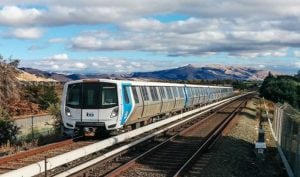
Government Marketing Case Study
Bay Area Rapid Transit District (BART)
Campaign Reach: Regional
Industry: Public Transportation
Services Rendered:
Search, Display
Retargeting
Social Media
Gmail Advertising
Rapid Growth for the Bay's Rapid Transit System
San Francisco’s Bay Area Rapid Transit District (BART) is the 5th most used rail transit system in the US and therefore faces many challenges. With a massive ridership of more than 430,000 a week and 129 million annually, communication with so many customers is vital.
Because of this, BART wanted to increase the number of opt-in subscribers to their “BARTable This Week” e-newsletter. Additionally, they wanted to drive more visits to their BARTable website, a cool site with all things near BART stations; Giants and A’s baseball games, art galleries, music venues, Super Bowl watch parties and more fun stuff — a great resource for people who are looking to take public transit to events.
BART teamed up with Zero Company to develop a multi-channel digital media marketing strategy to drive subscribers and site visitors with fantastic results.
The objective
Substantially increase opt-in subscriber base, drive site traffic and build digital audiences for future campaigns. The initial campaign would be based around a travel sweepstakes giveaway with a simple landing page.
The strategy
Retargeting allows you to market to users who have previously visited your site. We retargeted previous site visitors that did not convert after an initial site visit. Any visitor that came to the site from any marketing channel was shown display ads to remind them of the message and promotion.
As mentioned, building these retargeting lists was be essential for future campaigns. When we shifted gears later to promote another campaign such as a line closure, we had audiences already in place who had been to the BART sites. This allowed us to communicate important line closure updates to a large, “need to know” highly targeted audience.
Our search campaign targeted a variety of specific brand and non-brand keywords of users searching on Google. We also added retargeting overlays to our campaigns (meaning we were aggressive at showing our search ads to users who have previously visited the BART sites). Multiple ads and messages were split tested to improve results.
We had three campaigns for Facebook. First, a custom audience segment for retargeting visitors. Again, it was crucial for us to build retargeting lists for future campaigns. Leveraging equity built with this ad campaign into future campaigns allowed for efficient/effective ad spend as the year of campaigns continued.
Second, we again built lookalike audience modeling into this campaign to target users within our geotargets. The lookalike audience campaign uses machine to learning to target highly engaged traffic similar to our site visitors. This had the lowest cost per conversion of the three Facebook campaigns.
Lastly, we targeted a travel-interest audience within our geotarget to drive conversions. All three campaigns had spectacular results and were among our lowest cost per conversion.
Again, we used Twitter’s pixel to build a retargeting audience for this marketing channel. We also used similar audience modeling based on our existing site visitors to find users within the geotargets that might be interested in the campaign. Additional campaigns were build based around keywords.
The results
During the campaign:
- The site saw record traffic with more than 83,000 users and 111,000 sessions.
- Site traffic increased a staggering 175% over the previous month.
- Pages per session also increased 48%.
Impressively, nearly 50,000 new individuals signed up for the newsletter during the campaign.
The campaign had 9 million ad impressions over a few weeks.
Past performance in working with other government agencies allowed us to spend our budget efficiently and wisely. The conversion rates for these campaigns were sensational. Among the best were:
Twitter: 61% Conversion Rate
Facebook: 38% Conversion Rate
Search Engine Marketing: 16% Conversion Rate
Display: 11% Conversion Rate
Our Current Remarketing Audience Size: 2 million visitors
175%
Site traffic increase over previous month
16%
Search ad visitors converted to new subscribers
48%
Total pages viewed increased
Site traffic increase over previous month
Search ad visitors converted to new subscribers
Total pages viewed increased
Rapid Growth for the Bay's Rapid Transit System
Objective
Substantially increase opt-in subscriber base, drive site traffic and build digital audiences for future campaigns. The initial campaign would be based around a travel sweepstakes giveaway with a simple landing page.
Strategy
Target relevant audiences in Display, Search, Social Media and Gmail. We zeroed in on retargeting as a key component of the campaigns. Because ongoing communication and future digital campaigns would benefit from building equity here, we made sure we had a retargeting component to key marketing channels.
Geotargeting: Geotargets were set up around all of BART’s stations to target ads to commuters.
Geotargets were set up around all of BART’s stations to target ads to commuters.
Display:
We targeted several types of audiences for this channel. Since our giveaway theme was travel-based, we targeted to two campaigns with audiences that were “in-market” travel related — meaning these were people that were actively shopping for travel services within our geotargets. We also targeted an in-market Bus & Rail audiences within the geotarget. These are individuals likely to use BART. Additionally, we built campaigns based around certain affinity audiences (groups with predefined interests) and specific site placements.
Display Retargeting:
Retargeting allows you to market to users who have previously visited your site. We retargeted previous site visitors that did not convert after an initial site visit. Any visitor that came to the site from any marketing channel was shown display ads to remind them of the message and promotion.
As mentioned, building these retargeting lists was be essential for future campaigns. When we shifted gears later to promote another campaign such as a line closure, we had audiences already in place who had been to the BART sites. This allowed us to communicate important line closure updates to a large, “need to know” highly targeted audience.
Search Engine Marketing:
Our search campaign targeted a variety of specific brand and non-brand keywords of users searching on Google. We also added retargeting overlays to our campaigns (meaning we were aggressive at showing our search ads to users who have previously visited the BART sites). Multiple ads and messages were split tested to improve results.
Facebook:
We had three campaigns for Facebook. First, a custom audience segment for retargeting visitors. Again, it was crucial for us to build retargeting lists for future campaigns. Leveraging equity built with this ad campaign into future campaigns allowed for efficient/effective ad spend as the year of campaigns continued.
Second, we again built lookalike audience modeling into this campaign to target users within our geotargets. The lookalike audience campaign uses machine to learning to target highly engaged traffic similar to our site visitors. This had the lowest cost per conversion of the three Facebook campaigns.
Lastly, we targeted a travel-interest audience within our geotarget to drive conversions. All three campaigns had spectacular results and were among our lowest cost per conversion.
Twitter:
Again, we used Twitter’s pixel to build a retargeting audience for this marketing channel. We also used similar audience modeling based on our existing site visitors to find users within the geotargets that might be interested in the campaign. Additional campaigns were build based around keywords.
Gmail:
Because we were driving traffic to an email submit campaign, we targeting Gmail as another marketing channel. Like the display campaigns, we used “In-Market” and affinity audiences for targeting. Like the other campaigns, we split tested ad copy whenever possible to improve results.
Results
During the campaign:
- The site saw record traffic with more than 83,000 users and 111,000 sessions.
- Site traffic increased a staggering 175% over the previous month.
- Pages per session also increased 48%.
Impressively, nearly 50,000 new individuals signed up for the newsletter during the campaign.
The campaign had 9 million ad impressions over a few weeks.
Past performance in working with other government agencies allowed us to spend our budget efficiently and wisely. The conversion rates for these campaigns were sensational. Among the best were:
Twitter: 61% Conversion Rate
Facebook: 38% Conversion Rate
Search Engine Marketing: 16% Conversion Rate
Display: 11% Conversion Rate
Our Current Remarketing Audience Size: 2 million visitors
Bay Area Rapid Transit District (BART)
Campaign Reach: Regional
Industry: Public Transportation
Services Rendered:
- Search, Display
- Retargeting
- Social Media
- Gmail Advertising













